- California Assembly OKs highest minimum wage in nation
- S. Korea unveils first graphic cigarette warnings
- US joins with South Korea, Japan in bid to deter North Korea
- LPGA golfer Chun In-gee finally back in action
- S. Korea won’t be top seed in final World Cup qualification round
- US men’s soccer misses 2nd straight Olympics
- US back on track in qualifying with 4-0 win over Guatemala
- High-intensity workout injuries spawn cottage industry
- CDC expands range of Zika mosquitoes into parts of Northeast
- Who knew? ‘The Walking Dead’ is helping families connect
Koreans, Chinese enjoy subtle tweaks between original cuisine, localized dishes
SEOUL, July 20 (Yonhap) — Qi Lina, a 32-year-old Chinese instructor in Shenyang, northeastern China, and her husband are quite familiar with the traditional Korean dish of kimchi as the Chinese city has a Korean town and a large population of ethnic Koreans.
“Lately in the grocery store, they’ve been selling kimchi in two flavors: spicy hot and sweet,” Qi said in a telephone interview with Yonhap News Agency. “Sweet-flavored kimchi was new to me, so I bought some.”
Although Qi regretted not sticking to the mainstream, spicy hot kimchi, she still gave herself credit for trying something new.
Sweet kimchi is a complete novelty even in South Korea, the origin of the salty, fermented vegetable dish. Some young housewives pour a little lemon-lime soda over “mul kimchi,” or white, non-spicy kimchi, to add a subtle, carbonated finish, but that’s about it. No Korean cook has been so rebellious as to commercialize sweet kimchi.
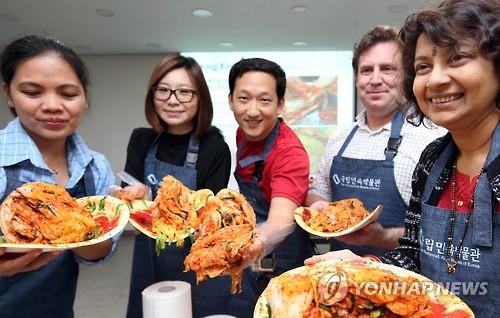
International participants make kimchi in a cultural event hosted by the National Museum of Korea in central Seoul on Nov. 23, 2015.
Qi’s experience provides an interesting insight into how the traditional food of one country can turn into a totally new dish in another after lengthy localization efforts, according to Choi Song-san, a professor at Hyejeon College in Hongseong, South Chungcheong Province. The Chinese cooking virtuoso with 35 years of in-kitchen experience in Chinese cuisine was one of the international judges at the 2016 Asian Master Chefs Competition in Korea held in central Seoul on June 18.
“I’ve never heard of sweet kimchi either, but it backs up what old chefs mean by ‘taste buds change at the turn of the decade,’” said Choi, born and raised in a Chinese ethnic Korean family.
“These days, Koreans and Chinese casually drink coffee after meals. But in the past, Chinese only drank hot Chinese tea and Koreans rice-broiled soup. This change in taste buds can happen with kimchi in China too. After all, local food of one region can become popular in another region, if there is enough time and experimental effort to tame the local people’s taste buds.”
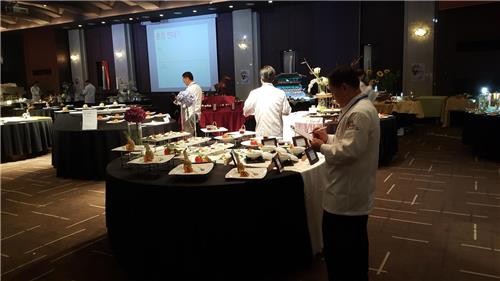
International judges evaluate dishes submitted to the 2016 Asian Master Chefs Competition in Korea in central Seoul on June 18, 2016.
As he passed myriad Chinese dishes submitted to the competition, the professor said that the most well-known example of such localization of ethnic food is “jjajangmyeon,” or jiajiangmian in Chinese, boiled noodles covered with black bean paste that originated in Beijing and became one of the most popular dishes in Korea.
“Prior to the localization of jjajangmyeon, Koreans felt the dry, bitter Chinese ‘gan jjajang’ unpalatable. Then, the first generational Chinese immigrants to Korea succeeded in developing the soft, juicy Korean ‘mul jjajang’ — something that Koreans of any family background or age group can easily gulp down.”
Now, the Korean-style jjajangmyeon has become very popular among Chinese tourists in Korea — pleasantly perplexing many Koreans.
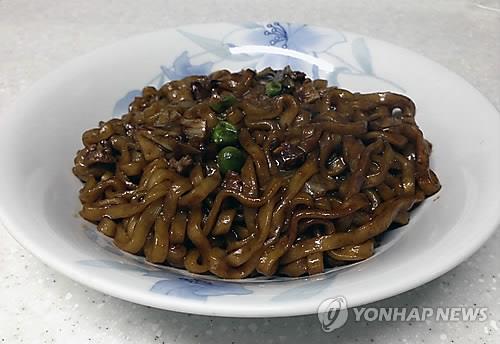
This undated file photo shows Korean-style “mul jjajang,” a localized dish of Chinese “jiajiangmian.”
The evolution of jjajangmyeon does not stop there.
Park Min-kwon, CEO of the fusion Chinese restaurant chain Taishan in Seoul, said he spends a lot of time developing new recipes for jjajangmyeon and other Chinese dishes to meet the new and changing demands of the younger generation.
He recently shot profile photos for Taishan’s new delicacies — Mozzarella cheese jjajang, Sichuan cream jjambbong, lemon bisque cream shrimp, Shanghai seafood omelet-covered rice and many more. Both jjajangmyeon enriched with coats of cheese and Sichuan jjambbong with cream sauce present an interesting, Italian sort of tweak at Korea’s localized Chinese cuisine.
“The original root of these dishes may have originated from China, but it is hard to make them out. Sichuan noodles are often associated with signature, burning red, which is not the case with Sichuan cream jjambbong,” he said, as he brushed his fingers through the photos of the mouthwatering dishes on his smartphone.
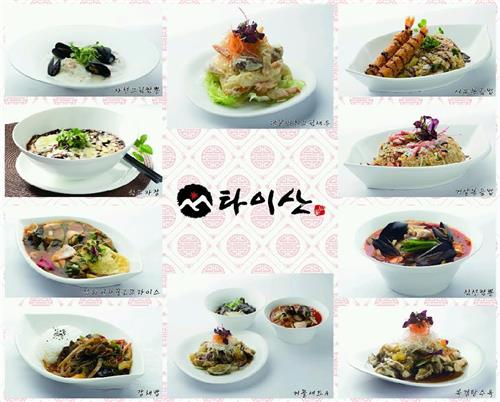
This profile photo provided by the fusion Chinese restaurant chain Taishan in Seoul shows its new seasonal dishes for this summer.
A successful localization of an ethnic dish requires more than a creative recipe. It needs local ingredients that appeal to local taste buds.
Zeng Zhongquan, a Taiwanese vice chief of a Chinese international epicurean association, said when he evaluates a Chinese dish, he appreciates the creative combination of the ingredients.
Zeng, who’s also one of the judges in the competition, said the nationality of competitors may be a key driver of the ingredients used in their submitted dishes.
“Ethnic cuisines have been expanding their horizons with the globalization of the culinary world. Take Chinese cuisine, for example, and you will see how diverse the ingredients can be for a single ethnic cuisine,” he said, as he finished judging dishes of master chefs from South Korea, Japan, China, Taiwan and Southeast Asian nations, competing to become the top master of Chinese cuisine.
Indeed, the individual competition section was full of local ingredients from the chefs’ countries, including crocodile, cricket, abalone and dragon fruit.
“You can still call all of them Chinese cuisine, but they exude individual charms of local food culture,” Zeng said. “This is the harmony that I admire every time that I look at the works of international master chefs.”
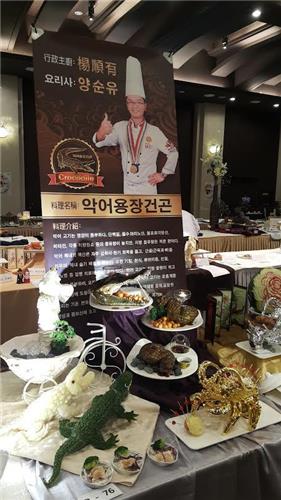
Chinese dishes made of crocodile are displayed in the 2016 Asian Master Chefs Competition in Korea held in central Seoul on June 18, 2016.








![일본 사도광산 [서경덕 교수 제공. 재판매 및 DB 금지]](http://www.koreatimesus.com/wp-content/uploads/2024/07/PYH2024072610800050400_P4-copy-120x134.jpg)


